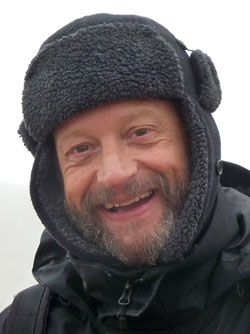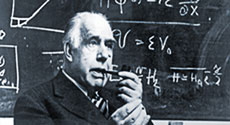Niels Bohr Lecture by Hans Jürgen Herrmann
Rotating Matter: The Bearing State

Niels Bohr Lecture by Hans Jürgen Herrmann. Rotating Matter: The Bearing State
Abstract: Granular materials are characterized by an additional degree of freedom, rotations, which become particularly relevant for spherical particles. They allow for soft modes under shear which do find realizations for instance in tectonic faults. A packing of spheres is called bi-chromatic if every loop formed by contacts is even.
In three dimensions, bi-chromatic bearings have many different sliding-free configurations, so called bearing states. If all loops have length four the system exhibits four continuous degrees of freedom and a systematic way of constructing such bearing states can be devised.
The bearing state can be analytically predicted from the initial state without any information about the nature of the contact forces. Any bearing state can be induced by controlling the angular velocities of only two spheres. This allows for instance to amplify the angular velocity along a two parallel touching chains of equally sized spheres as a new way of gear design, that might find use in mechanics and robotics. When a single sphere is blocked a well-defined new bearing state is attained. It is also possible to determine the total mass and the center of mass of the packing by analyzing its response to changes of the angular velocities of at most two spheres.
By considering spheres of different size, packings with bearing states can even be made space-filling. The construction and mechanical properties of such space-filling bearings will be discussed. Their bearing states can be viewed as a realization of solid turbulence exhibiting Kolmogorov scaling and anomalous heat conduction. In three dimensions a continuum of such configurations can be obtained as cuts through four-dimensional space-filling bearing states.
Wednesday, October 12, 2016 at 15:15 in Aud. 3 at HCØ.
About the speaker: Hans Jürgen Herrmann is a theoretical physicist and professor at ETH Zürich. PhD in Cologne (1981) in statistical physics and then after one year post-doc in the US member of CNRS at the Service de Physique Théorique in Saclay (France) being today Directeur de Recherche 1ère Class in section 02; from 1990 till 1994 head of the many-body group at HLRZ of KFA Jülich (Germany) for four years, then from 1994 till 2000, chaired professor and director of the PMMH of ESPCI, Paris for six years; from 1996 to 2006, full professor and director of the Institute of Computer Physics at the University of Stuttgart (Germany); since April 2006 full Professor at the Institute of Building Materials at ETH Zürich (Switzerland); Guggenheim Fellow (1986), member of the Brazilian Academy of Science, Max-Planck prize recipient (2002) and Gentner-Kastler prize (2004); ERC Advanced (2012); managing editor of International Journal of Modern Physics C and of Granular Matter and member of several editorial boards and committees including the Research Commission of ETH; author of about 570 publications and co-editor of 13 books.
His education is based on theoretical solid state physics (master) and statistical physics of critical phenomena (PhD). After his PhD he worked among others on gelation and irreversible growth and built a special purpose computer to calculate the conductivity of percolation clusters. He has studied the fracture of heterogeneous materials since 1986 and since 1992, he has investigated the properties of granular media. Highlights in this research were the construction of space-filling bearings and the establishment of the equations of motion of dunes. His present research subjects include watersheds, the formation of river deltas, quicksand, relativistic fluids, the failure of fibrous and polymeric composites and complex networks.
|
Coffee and Cookies
|

 Niels Bohr Lectures
Niels Bohr Lectures 